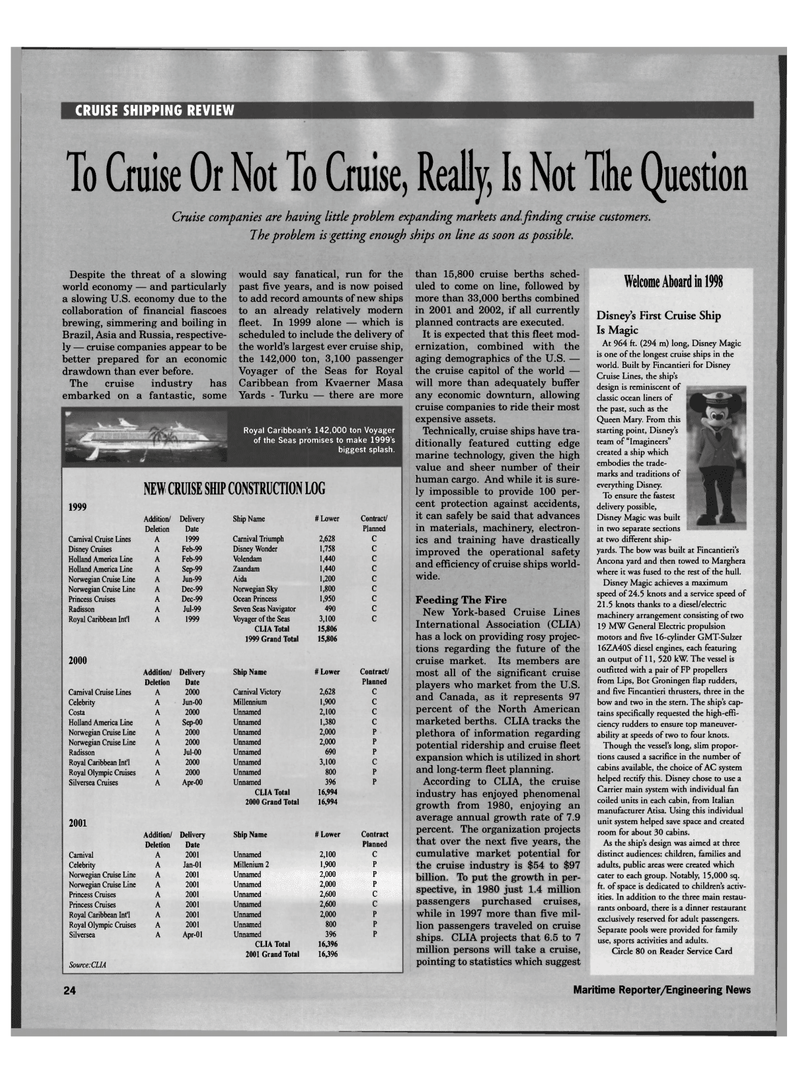
Page 27: of Maritime Reporter Magazine (February 1999)
Read this page in Pdf, Flash or Html5 edition of February 1999 Maritime Reporter Magazine
CRUISE SHIPPING REVIEW
To Cruise Or Not To Cruise, Really, Is Not The Question
Cruise companies are having little problem expanding markets and finding cruise customers.
The problem is getting enough ships on line as soon as possible.
Despite the threat of a slowing world economy — and particularly a slowing U.S. economy due to the collaboration of financial fiascoes brewing, simmering and boiling in
Brazil, Asia and Russia, respective- ly — cruise companies appear to be better prepared for an economic drawdown than ever before.
The cruise industry has embarked on a fantastic, some would say fanatical, run for the past five years, and is now poised to add record amounts of new ships to an already relatively modern fleet. In 1999 alone — which is scheduled to include the delivery of the world's largest ever cruise ship, the 142,000 ton, 3,100 passenger
Voyager of the Seas for Royal
Caribbean from Kvaerner Masa
Yards - Turku — there are more
Royal Caribbean's 142,000 ton Voyager of the Seas promises to make 1999's biggest splash.
NEW CRUISE SHIP CONSTRUCTION LOG 1999
Addition/ Delivery Ship Name # Lower Contract/
Deletion Date Planned
Carnival Cruise Lines A 1999 Carnival Triumph 2,628 C
Disney Cruises A Feb-99 Disney Wonder 1,758 C
Holland America Line A Feb-99 Volendam 1,440 c
Holland America Line A Sep-99 Zaandam 1,440 c
Norwegian Cruise Line A Jun-99 Aida 1,200 c
Norwegian Cruise Line A Dec-99 Norwegian Sky 1,800 c
Princess Cruises A Dec-99 Ocean Princess 1,950 c
Radisson A Jul-99 Seven Seas Navigator 490 c
Royal Caribbean Int'l A 1999 Voyager of the Seas 3,100 c
CLIA Total 15,806 1999 Grand Total 15,806 2000
Addition/ Delivery Ship Name # Lower Contract/
Deletion Date Planned
Carnival Cruise Lines A 2000 Carnival Victory 2,628 C
Celebrity A Jun-00 Millennium 1,900 C
Costa A 2000 Unnamed 2,100 C
Holland America Line A Sep-00 Unnamed 1,380 C
Norwegian Cruise Line A 2000 Unnamed 2,000 P
Norwegian Cruise Line A 2000 Unnamed 2,000 P
Radisson A Jul-00 Unnamed 690 P
Royal Caribbean Int'l A 2000 Unnamed 3,100 C
Royal Olympic Cruises A 2000 Unnamed 800 P
Silversea Cruises A Apr-00 Unnamed 396 P
CLIA Total 16,994 2000 Grand Total 16,994 2001
Addition/ Delivery Ship Name # Lower Contract
Deletion Date Planned
Carnival A 2001 Unnamed 2,100 C
Celebrity A Jan-01 Millenium 2 1,900 P
Norwegian Cruise Line A 2001 Unnamed 2,000 P
Norwegian Cruise Line A 2001 Unnamed 2,000 P
Princess Cruises A 2001 Unnamed 2,600 C
Princess Cruises A 2001 Unnamed 2,600 C
Royal Caribbean Int'l A 2001 Unnamed 2,000 P
Royal Olympic Cruises A 2001 Unnamed 800 P
Silversea A Apr-01 Unnamed 396 P
CLIA Total 16,396 2001 Grand Total 16,396
Source: CLIA than 15,800 cruise berths sched- uled to come on line, followed by more than 33,000 berths combined in 2001 and 2002, if all currently planned contracts are executed.
It is expected that this fleet mod- ernization, combined with the aging demographics of the U.S. — the cruise capitol of the world — will more than adequately buffer any economic downturn, allowing cruise companies to ride their most expensive assets.
Technically, cruise ships have tra- ditionally featured cutting edge marine technology, given the high value and sheer number of their human cargo. And while it is sure- ly impossible to provide 100 per- cent protection against accidents, it can safely be said that advances in materials, machinery, electron- ics and training have drastically improved the operational safety and efficiency of cruise ships world- wide.
Feeding The Fire
New York-based Cruise Lines
International Association (CLIA) has a lock on providing rosy projec- tions regarding the future of the cruise market. Its members are most all of the significant cruise players who market from the U.S. and Canada, as it represents 97 percent of the North American marketed berths. CLIA tracks the plethora of information regarding potential ridership and cruise fleet expansion which is utilized in short and long-term fleet planning.
According to CLIA, the cruise industry has enjoyed phenomenal growth from 1980, enjoying an average annual growth rate of 7.9 percent. The organization projects that over the next five years, the cumulative market potential for the cruise industry is $54 to $97 billion. To put the growth in per- spective, in 1980 just 1.4 million passengers purchased cruises, while in 1997 more than five mil- lion passengers traveled on cruise ships. CLIA projects that 6.5 to 7 million persons will take a cruise, pointing to statistics which suggest
Welcome Aboard in 1998
Disney's First Cruise Ship
Is Magic
At 964 ft. (294 m) long, Disney Magic is one of the longest cruise ships in the world. Built by Fincantieri for Disney
Cruise Lines, the ship's design is reminiscent of classic ocean liners of the past, such as the
Queen Mary. From this starting point, Disney's team of "Imagineers" created a ship which embodies the trade- marks and traditions of everything Disney.
To ensure the fastest delivery possible,
Disney Magic was built in two separate sections at two different ship- yards. The bow was built at Fincantieri's
Ancona yard and then towed to Marghera where it was fused to the rest of the hull.
Disney Magic achieves a maximum speed of 24.5 knots and a service speed of 21.5 knots thanks to a diesel/electric machinery arrangement consisting of two 19 MW General Electric propulsion motors and five 16-cylinder GMT-Sulzer 16ZA40S diesel engines, each featuring an output of 11, 520 kW. The vessel is outfitted with a pair of FP propellers from Lips, Bot Groningen flap rudders, and five Fincantieri thrusters, three in the bow and two in the stern. The ship's cap- tains specifically requested the high-effi- ciency rudders to ensure top maneuver- ability at speeds of two to four knots.
Though the vessel's long, slim propor- tions caused a sacrifice in the number of cabins available, the choice of AC system helped rectify this. Disney chose to use a
Carrier main system with individual fan coiled units in each cabin, from Italian manufacturer Atisa. Using this individual unit system helped save space and created room for about 30 cabins.
As the ship's design was aimed at three distinct audiences: children, families and adults, public areas were created which cater to each group. Notably, 15,000 sq. ft. of space is dedicated to children's activ- ities. In addition to the three main restau- rants onboard, there is a dinner restaurant exclusively reserved for adult passengers.
Separate pools were provided for family use, sports activities and adults.
Circle 80 on Reader Service Card 24 Maritime Reporter/Engineering News

 26
26

 28
28
